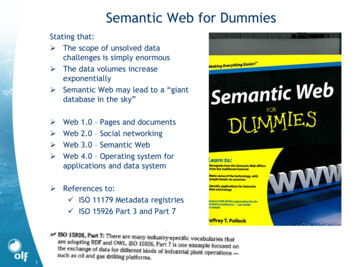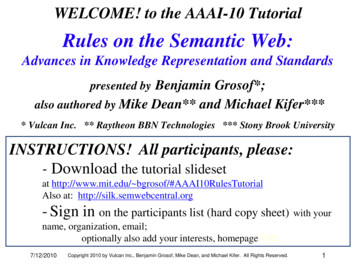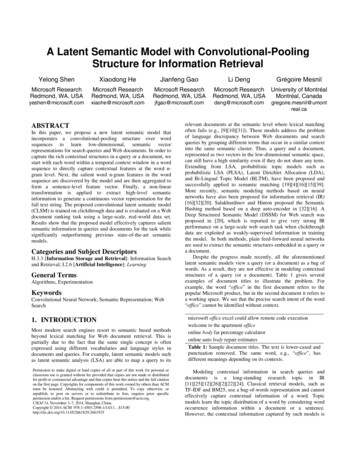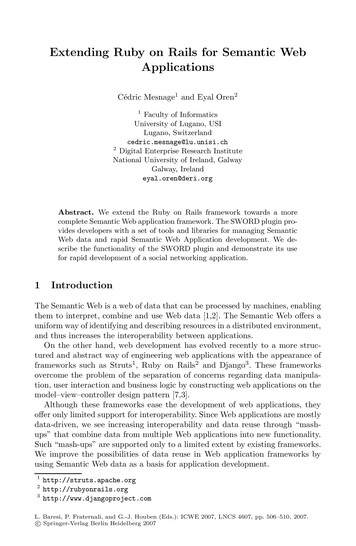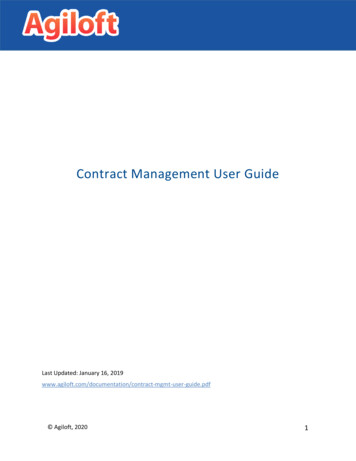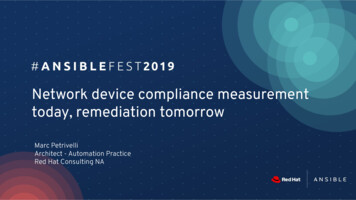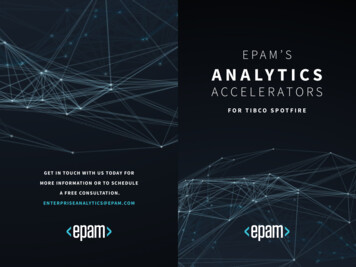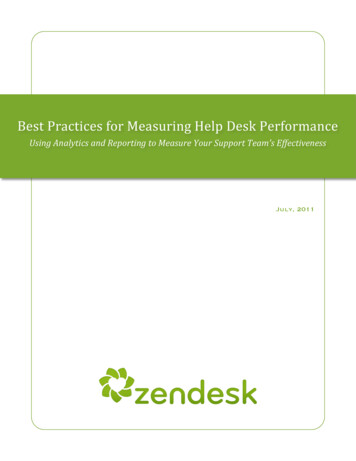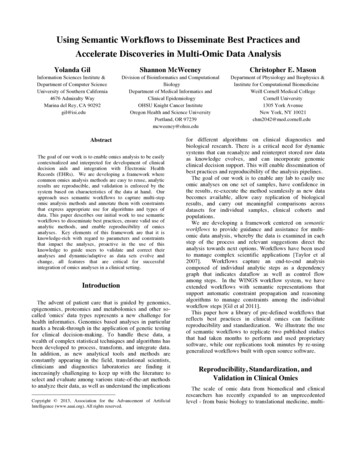
Transcription
Using Semantic Workflows to Disseminate Best Practices andAccelerate Discoveries in Multi-Omic Data AnalysisYolanda GilShannon McWeeneyInformation Sciences Institute &Department of Computer ScienceUniversity of Southern California4676 Admiralty WayMarina del Rey, CA 90292gil@isi.eduDivision of Bioinformatics and ComputationalBiologyDepartment of Medical Informatics andClinical EpidemiologyOHSU Knight Cancer InstituteOregon Health and Science UniversityPortland, OR 97239mcweeney@ohsu.eduAbstractThe goal of our work is to enable omics analysis to be easilycontextualized and interpreted for development of clinicaldecision aids and integration with Electronic HealthRecords (EHRs). We are developing a framework wherecommon omics analysis methods are easy to reuse, analyticresults are reproducible, and validation is enforced by thesystem based on characteristics of the data at hand. Ourapproach uses semantic workflows to capture multi-stepomic analysis methods and annotate them with constraintsthat express appropriate use for algorithms and types ofdata. This paper describes our initial work to use semanticworkflows to disseminate best practices, ensure valid use ofanalytic methods, and enable reproducibility of omicsanalyses. Key elements of this framework are that it isknowledge-rich with regard to parameters and constraintsthat impact the analyses, proactive in the use of thisknowledge to guide users to validate and correct theiranalyses and dynamic/adaptive as data sets evolve andchange, all features that are critical for successfulintegration of omics analyses in a clinical setting.IntroductionThe advent of patient care that is guided by genomics,epigenomics, proteomics and metabolomics and other socalled 'omics' data types represents a new challenge forhealth informatics. Genomics based analyses in particularmarks a break-through in the application of genetic testingfor clinical decision-making. To handle these data, awealth of complex statistical techniques and algorithms hasbeen developed to process, transform, and integrate data.In addition, as new analytical tools and methods areconstantly appearing in the field, translational scientists,clinicians and diagnostics laboratories are finding itincreasingly challenging to keep up with the literature toselect and evaluate among various state-of-the-art methodsto analyze their data, as well as understand the implicationsCopyright 2013, Association for the Advancement of ArtificialIntelligence (www.aaai.org). All rights reserved.Christopher E. MasonDepartment of Physiology and Biophysics &Institute for Computational BiomedicineWeill Cornell Medical CollegeCornell University1305 York AvenueNew York, NY 10021chm2042@med.cornell.edufor different algorithms on clinical diagnostics andbiological research. There is a critical need for dynamicsystems that can reanalyze and reinterpret stored raw dataas knowledge evolves, and can incorporate genomicclinical decision support. This will enable dissemination ofbest practices and reproducibility of the analysis pipelines.The goal of our work is to enable any lab to easily useomic analyses on one set of samples, have confidence inthe results, re-execute the method seamlessly as new databecomes available, allow easy replication of biologicalresults, and carry out meaningful comparisons acrossdatasets for individual samples, clinical cohorts andpopulations.We are developing a framework centered on semanticworkflows to provide guidance and assistance for multiomic data analysis, whereby the data is examined in eachstep of the process and relevant suggestions direct theanalysis towards next options. Workflows have been usedto manage complex scientific applications [Taylor et al2007].Workflows capture an end-to-end analysiscomposed of individual analytic steps as a dependencygraph that indicates dataflow as well as control flowamong steps. In the WINGS workflow system, we haveextended workflows with semantic representations thatsupport automatic constraint propagation and reasoningalgorithms to manage constraints among the individualworkflow steps [Gil et al 2011].This paper how a library of pre-defined workflows thatreflects best practices in clinical omics can facilitatereproducibility and standardization. We illustrate the useof semantic workflows to replicate two published studiesthat had taken months to perform and used proprietarysoftware, while our replications took minutes by re-usinggeneralized workflows built with open source software.Reproducibility, Standardization, andValidation in Clinical OmicsThe scale of omic data from biomedical and clinicalresearchers has recently expanded to an unprecedentedlevel - from basic biology to translational medicine, multi-
omic data can enable phenomenal discoveries [Shendureand Ji 2008]. There is a dramatic shift from discoveryresearch into clinical implementation. However, the abilityto integrate and interrogate multiple 'omic data sets iscritical for the understanding of disease and will only beaccomplished through stringent data management,analysis, interpretation, and quantification. Ultimately,placing validated analytical tools in the hands ofbiomedical experts, and translating insights found betweendiverse datasets, will ensure that patients receive thecorrect diagnosis and individualized treatment.Genetic testing for patient care has evolvedtremendously over the past 50 years. Metaphasekaryotyping has been used to diagnose disease sinceapproximately 1960. The development of fluorescently orradioactively labeled probe hybridization approachesbrought further advances in chromosomal analysis[Tsuchiya 2011]. The advent of PCR and the developmentof DNA sequencing allowed the first gene variant tests tobe introduced into clinical laboratories. Subsequently,microarray technologies have supported genome-wideanalyses of chromosomal gains and losses as well as globalgene expression profiles. Deep sequencing technologiesrepresent the next step forward and have the potential toreplace several of these other diagnostic approaches. Tohandle these data, a wealth of complex statisticaltechniques and algorithms has been developed to process,transform, and integrate data. In addition, there is a furtherlayer of complexity due to the evolving annotation foromics results that provides critical context for clinicalinterpretability.A continually updating system that can aid inreproducibility, standardization, and validation of theseworkflows is needed to facilitate this transition from theresearch setting to the clinical setting.Capturing Omics Analyses as WorkflowsA computational experiment specifies how selecteddatasets are to be processed by a series of software oranalytical components in a particular configuration. Forexample, biologists use computational experiments foranalysis of RNA-seq or molecular interaction networks andpathways Computational workflows represent complexapplications as a dependency graph of computations linkedthrough control or data flow. Workflow systems managethe execution of these complex computations, recordprovenance of how results are generated, and allow endusers with little or no programming background to createapplications by reusing pre-defined workflows that othershave built [Taylor et al 2007]. Popular workflow systemsin omics include GenePattern [Reich et al 2006], Galaxy[Giardine et al 2005] and Taverna [Oinn et al 2006].All these systems help users by providing easy access toheterogeneous tools organized in workflows. However, animportant challenge for these systems is that they oftenexist with simple descriptions that provide no semantics asto what inputs they expect and what outputs they produce.Researchers often need better guidance and dynamicchecks of the data, to ensure workflow validity andreproducibility. This is particularly critical as omics movesfrom research to clinical settings, where standardization ofomics workflows is necessary to allow meaningfulcomparisons across datasets as well as updating resultswhen new algorithms or data become available.ReproducibilityScientific articles often describe computational methodsinformally, often requiring a significant effort from othersto reproduce and to reuse. Reproducibility is a cornerstoneof scientific method, so it is important that reproducibilitybe possible not just in principle but in practice in terms oftime and effort to the original team and to the reproducers.The reproducibility process can be so costly that it hasbeen referred to as “forensic” research [Baggerly andCoombes 2009]. Studies have shown that reproducibility isoften not achievable from the article itself [Bell et al 2009;Ioannidis et al 2009]. Retractions of publications do occur,more often than is desirable - a recent editorial proposedtracking the “retraction index” of journals to indicate theproportion of published articles that are later foundproblematic [Fang and Casadevall 2011]. Publishersthemselves are asking the community to end “black box”science that cannot be easily reproduced [Nature 2006].The need for reproducibility in the clinical arena is welldocumented. Clinical trials based on erroneous resultspose significant threats to patients [Hutson 2010]. Inaddition, pharmaceutical companies have reported millionsof dollars in losses due to irreproducible results thatseemed initially promising [Naik 2011].Computational reproducibility is in itself a relativelymodern concept. Scientific publications could be extendedso that they incorporate computational workflows, as manyalready include data [Bourne 2010]. However, withoutaccess to the source codes for the papers, reproducibilityhas been shown elusive [Hothorn and Leisch 2011]. Somesystems exist that augment publications with scripts orworkflows, such as Weaver for Latex [Falcon 2007] andGenePattern for MS Word [Mesirov 2010].Repositories of shared workflows enable scientists toreuse workflows published by others and facilitatereproducibility [De Roure et al 2009]. The OpenProvenance Model (OPM) [Moreau et al 2011] wasdeveloped to allow workflow systems to publish andexchange workflow execution provenance, thereforefacilitating reproducibility.Semantic Workflows in WINGSWINGS is a semantic workflow system that assistsscientists with the design and reproducibility ofcomputational experiments [Gil et al 2011a; Gil et al2011b]. Relevant publications and open source softwareare available from http://www.wings-workflows.org.
catalog'Figure 1. High-level architecture diagram of the WINGSsemantic workflow system.A high-level diagram of the architecture of WINGS isprovided in Figure 1. A unique feature of WINGS is thatits workflow representations incorporate semanticconstraints about datasets and workflow components.WINGS represents semantic constraints that capturedataset properties and component requirements. Wingsincludes algorithms that use these representations forautomated workflow elaboration, workflow matching,provenance and metadata generation, data-driven adaptiveworkflow customization, parallel data processing,workflow validation, and interactive assistance.WINGS adopts the emerging W3C PROV standard forWeb provenance to publish workflow executions [Gil andMiles 2013]. In addition, WINGS publishes workflowtemplates to enable reuse and reproducibility by otherworkflow systems [Garijo and Gil 2011]. The workflowsand their execution records are published as semantic webobjects using linked data principles, which means that allthe provenance entities are accessible as web objects with aunique URI and represented in RDF. This includes theworkflow execution and all associated artifacts such asdata products, application codes, and parameter settings.An advantage of this approach is that the workflows can belinked to millions of other entities already published aslinked data, including numerous biomedical datarepositories (e.g., GO, KEGG, PDB). The integration ofsuch domain knowledge with workflows has been exploredin the SADI framework [Wood et al 2012].Capturing Best Practices in Omics AnalysisWe are developing a growing collection of workflows forgenomic analysis, including population studies, inter- andintra-family studies, and next generation sequencing [Gil etal 2012]. It currently has workflows for: 1) Associationtests, including association test conditional on matchingthat includes population stratification, a general associationtest that assumes that outliers have been removed, and astructured association test; 2) Copy number variation(CNV) detection, which use ensembles of algorithms withdifferent algorithm combinations; 3) Transmissiondisequilibrium test (TDT) to conduct association testingfor disease traits, in some cases incorporating parentalphenotype information; and 4) Variant discovery fromresequencing of genomic DNA and RNA sequencing.The workflows include software components from thefollowing packages: Plink (genome association studiestoolset), R (statistical computing and graphics), PennCNVand Gnosis (CNV detection), Allegro and FastLink(linkage analysis), Burrows-Wheeler Aligner andSAMTools (sequence alignment), and Structure(population studies).Figure 2 shows an RNA-Sequencing workflow, wherebeige boxes are data and blue circles are algorithmsexecuted as the workflow runs. There are seven alignmentsteps (genome, junction, fusion, polyA, polyT, miR, andpaired) in the analysis of RNA-Seq data, and each can beintegrated with other workflows downstream. The yellowboxes highlight how the workflow is automaticallyelaborated by WINGS to process data collections inparallel, annotating each result with semantic metadata.Semantic constraints are used to validate omic analysesby checking the integrity of the data. This quality controlcan reveal data fidelity and sample integrity problems,ruling out incorrect samples for many reasons (tubemixups, non-paternity, technician error, labeling errors,etc). The workflows accept the familial relationships ifknown (pedigree file, or pedfile) and the raw genotypingdata files (Affymetrix or Illumina) or sequencing(Illumina), import the data into memory, and format thedata. For data with family information, we make extensiveuse of Plink tools as well as our own data-checking code.When pedigree data is present, it is used to validate thefamily structure and each sampleʼs characteristics byexamining all of the family members, their relationships,sex, and status (affected or unaffected). We examine thefamily structure and ensured that all of the family membersare related, based on their pairwise identity-by-statedistances. Then, we determine the “molecular sex” for eachsample, based upon the rate of heterozygosity on the Xchromosome. In each case, the workflow reasoners ensurethe appropriate parameters and constraints are met beforethe next processing step is executed.Reproducibility through Workflow andProvenance PublicationTo illustrate how workflows can enable standardizationof analysis and reproducibility, we discuss the replicationof two published disease studies from the literature. Theoriginal studies did not use a workflow system, and all thesoftware components were executed by hand. While theseexamples are focused on translational research in complexdiseases, the framework is equally applicable to diagnosticclinical omics workflows as well.
Figure 2: An RNA-Sequencing workflow is automatically elaborated by the system to process data collections in parallel.We replicated the results of a study reported in [Duerr etal 06], which found a significant association between theIL23R gene on chromosome 1p31 and Crohn’s disease. Toreproduce the result, we used one of the workflows in ourlibrary for association test conditional on matching. It usesthe Cochran-Mantel-Haenszel (CMH) association statisticto do an association test conditional on the matching donein the population stratification step. There are two inputdatasets to this workflow. One is a pedigree file, with oneentry per individual with its unique identifier, gender,identifiers for each parent, phenotype information (aquantitative trait or an affection status), and optionallygenotype information (given as two alleles per marker).The other input is a genetic map file that specifies themarkers, one per line, including the chromosome identifier,SNP identifier, and position. The workflow componentsinclude the Inheritance-by-Structure (IBS) clusteringalgorithm from Plink for population stratification, theCMH association test from Plink, and the R package forplotting results.The pedigree dataset included 883families with genotypic information for both parents and atleast one offspring. The size of the file was 2.4 GB, themap dataset 10 MB. Figure 3 shows the results, each pointplotted is a SNP and we highlight with a circle the points inChromosome 1 with a log p value above 4.00. All fiveSNPs are in the IL23R gene, which was the main result ofthe study. The run time of the workflow was 19.3 hours.Most workflow components took minutes to execute. Thepopulation stratification step took 19 hours to run, as didthe visualization step, both were executed concurrently.We also replicated another previously published resultfor CNV association [Bayrakli et al., 2007]. Using one ofour workflows for CNV detection, we saw a CNV at theexpected locus over the PARK2 gene for ,520,00).Figure 4shows the results. Each spot represents a probe onthe arrays, with the x-axis representing coordinates onchromosome6 and the y-axis representing the averagelog2ratio of the patient versus control intensity at the sameprobe. Our workflow had 16 steps and run in 34 mins.Some observations that we make from these studies are: A library of carefully crafted workflows of select stateof-the-art methods will cover a very large range ofgenomic analyses. The workflows that we used to
replicate the results were independently developed andwere unchanged. They were designed with no notionof the original studies. Workflow systems enable efficient set up of analyses.The replication studies took seconds to set up. Therewas no overhead incurred in downloading or settingup software tools, reading documentation, or typingcommands to execute each step of the analysis. It is important to abstract the conceptual analysis beingcarried out away from the details of the executionenvironment. The software components used in theoriginal studies were not the same than those in ourworkflows. In the original study for Crohn’s disease,the CMH statistic was done with the R package, andthe rest of the steps were done with R and the FBATsoftware, while our workflow used CMH and theassociation test from Plink and the plotting from R.Our workflows are described in an abstract fashion,independent of the specific software componentsexecuted. In the original Parkinson’s study, theCircular Binary Segment (CBS) algorithm for CNVdetection was used, while our workflow used a stateof-the-art method that combines evidence from threenewer algorithms. Our workflows contain state-ofthe-art methods that can be readily applied. Semantic constraints can be added to workflows to avoidanalysis errors. The first workflow that we submittedwith the original Crohn’s disease study dataset failed.Examining the trace and the documentation of thesoftware for association test we realized that noduplicate individuals can be present. Upon manualexamination we discovered that there were threeduplicated individuals in the dataset. We removedthem by hand and the workflow executed with noproblems. The workflow now includes a constraintthat the input data for the association test cannotcontain duplicate individuals, which results in theprior step having a parameter set to remove duplicates.The time savings to future users could be significant.Our framework allows easy replication of biologicalresults and meaningful comparisons across datasets forindividual samples, clinical cohorts and populations. Ourgoal is to enable omics analysis to be easily contextualizedamong appropriately matched, similarly analyzed, andbiologically relevant data from within the same person(tumor/normal) or in the context of other genomes.DiscussionIn future work, we plan to further extend the means tofilter, validate, and combine data that goes into theworkflows. The integration and processing of the raw datais so critical because any errors in this first phase willcontaminate the results of all subsequent steps. Thisrequires adding to the workflows constraints for checkingvarious aspects of the data such as sample integrity andgenomic integrity. Additional steps and semanticFigure 3. Results of the Crohn’s disease replication.Figure 4. Results of the Parkinson’s disease replication.constraints can be added to expand the validity checks forgender, genome build, base composition, alignment rates,genome coordinates, and base types.Figure 5 shows an example of an integrated RNA-seqworkflow in WINGS that requires more advancedconstraints and filtering. Alignments across N referencegenomes or transcritptomes can be stored in BioHDF(http://www.hdfgroup.org/projects/biohdf/), and the readscan be hierarchically extracted for subsequent analysis.First, reads that map to a reference are used for variantprediction and allele-specific variation detection. Thosereads are counted and converted into expression measuresfor all known genes/transcripts, which can then be used topredict the tissue source, then the remainder of the readsare used for gene fusion detection. The last set of reads arechecked for the presence of any other genomes that arepresent, such as the re-constituted HPV genomes that wespiked into these sequences. If no other genomes arefound, the system will prompt the user to attempt a de novoassembly of the remaining reads.
Figure 5. Integrated workflows for clinical omics.ConclusionsWe have described the use of semantic workflows to assistusers in: 1) validating their use of workflows for complexgenomic analyses, 2) readily and reliably replicating priorstudies, and 3) finding published datasets to support theirongoing analysis. Semantic workflows can provide keycapabilities needed to handle the complexities ofpopulation genomics, particularly given the new challengesof the upcoming NGS technologies.Key elements of our approach that are critical for theeffectiveness of our framework are that: 1) it is knowledgerich with regard to parameters and constraints that impactthe analyses, 2) it is proactive in the use of this knowledgeto guide users to validate and correct their analyses, and 3)it is dynamic/adaptive as data sets evolve and change.Our goal is to support reproducibility, standardization,and validation of omics workflows to accelerate thediscovery of new genetic variations that contribute tohuman disease, as well as support the translation of thesefindings to the clinical and diagnostics setting.Acknowledgments.We would like to thank EwaDeelman and Varun Ratnakar for valuable discussions.ReferencesBaggerly, K. A. and Coombes, K. R. “Deriving Chemosensitivityfrom Cell Lines: Forensic Bioinformatics and ReproducibleResearch in High-Throughput Biology.” Annals of AppliedStatistics, 3(4), 2009.Bayrakli F, Bilguvar K, Mason, CE, et al. “Rapid identificationof disease-causing mutations using copy number analysiswithin linkage intervals.” Human Mutation, 28(12), 2007.Bell AW, and the Human Proteome Organization (HUPO) TestSample Working Group. “A HUPO test sample study revealscommon problems in mass spectrometry–based proteomics.”Nature Methods, 6(6), 2009.Bourne, P. “What Do I Want from the Publisher of the Future?”PLoS Computational Biology, 2010.De Roure, D; Goble, C.; Stevens, R. “The design and realizationsof the myExperiment Virtual Research Environment for socialsharing of workflows”. Future Generation Computer Systems,25, 2009.Duerr RH, Taylor KD, et al. “A genome-wide association studyidentifies IL23R as an inflammatory bowel disease gene.”Science, 314(5804):1461-3. Dec 1, 2006.Falcon, S. “Caching code chunks in dynamic documents: Theweaver package.” Computational Statistics, (24)2, 2007.Fang, C.F., and Casadevall, A. “Retracted Science and theretracted index”. Infection and Immunity. 2011.Garijo, D. and Y. Gil. “A New Approach for PublishingWorkflows: Abstractions, Standards, and Linked Data.”Proceedings of the 6th Workshop on Workflows in Support ofLarge-Scale Science (WORKS-11), Seattle, WA, 2011.Giardine B, Riemer C, et al. “Galaxy: a platform for interactivelarge-scale genome analysis.” Genome Research 15(10), 2005.Gil, Y.; Gonzalez-Calero, P. A.; Kim, J.; Moody, J.; andRatnakar, V. “A Semantic Framework for AutomaticGeneration of Computational Workflows Using DistributedData and Component Catalogs.” Journal of Experimental andTheoretical Artificial Intelligence, 23(4), 2011.Gil, Y., Ratnakar, V., Kim, J., Gonzalez-Calero, P. A., Groth, P.,Moody, J., and E. Deelman. “Wings: Intelligent WorkflowBased Design of Computational Experiments.” IEEEIntelligent Systems, 26(1), 2011.Gil, Y., Deelman, E. and C. Mason. “Using Semantic Workflowsfor Genome-Scale Analysis.” International Conference onIntelligent Systems for Molecular Biology (ISMB), 2012.Gil, Y. and S. Miles (Eds). “PROV Model Primer.” TechnicalReport of the World Wide Web Consortium (W3C), 2013.Hothorn, T. and F. Leisch. “Case Studies in Reproducibility.”Briefings in Bioinformatics, 12(3), 2011.Hull, D, Wolstencroft, K, Stevens, R, Goble, C, Pocock, M, Li, P,and T. Oinn. “Taverna: A Tool for Building and RunningWorkflows of Services”, Nucleic Acids Research, 34, 2006.Hutson, S. “Data Handling Errors Spur Debate Over ClinicalTrial,” Nature Medicine, 16(6), 2010.Mesirov, JP. “Accessible Reproducible Research.” Science,327:415, 2010.Moreau, L., Clifford, B., Freire, J., Futrelle, J., Gil, Y., Groth, P.,Kwasnikowska, N., Miles, S., Missier, P., et al. “The OpenProvenance Model Core Specification (v1.1).” FutureGeneration Computer Systems, 27(6), 2011.Nature Editorial. “Illuminating the Black Box.” Nature,442(7098), 2006.Naik, G. “Scientists' Elusive Goal: Reproducing Study Results.”The Wall Street Journal, December 2, 2011.Reich, M., Liefeld, et al. “GenePattern 2.0”. Nature Genetics38(5):500-501, 2006.Shendure, J & Ji, H. “Next-generation DNA sequencing.” NatBiotechnol 26, 1135-45, 2008.Taylor, I., Deelman, E., Gannon, D., Shields, M., (Eds).Workflows for e-Science, Springer Verlag, 2007.Tsuchiya, KD. “Fluorescence in situ hybridization.” Clin LabMed 31, 2011.Wood, I., Vandervalk, B., McCarthy, L., and M. D. Wilkinson.“OWL-DL Domain-Models as Abstract Workflows”.Proceedings of ISoLA, 2012.
Information Sciences Institute & Department of Computer Science University of Southern California 4676 Admiralty Way Marina del Rey, CA 90292 gil@isi.edu Shannon McWeeney Division of Bioinformatics and Computational Biology Department of Medical Informatics and Clinical Epidemiology OHSU Kni
